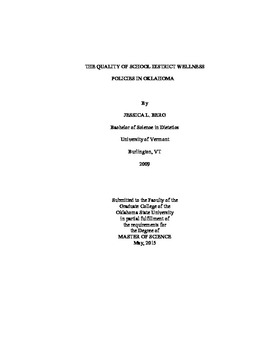| dc.contributor.advisor | Fink, Kevin | |
| dc.contributor.advisor | Betts, Nancy | |
| dc.contributor.author | Berg, Jessica | |
| dc.date.accessioned | 2016-04-15T21:49:10Z | |
| dc.date.available | 2016-04-15T21:49:10Z | |
| dc.date.issued | 2015-05-01 | |
| dc.identifier.uri | https://hdl.handle.net/11244/33391 | |
| dc.description.abstract | Federal laws requiring schools to develop local wellness policies have the potential to prevent childhood obesity by improving school nutrition and physical activity environments. School environments are of great importance because of the significant amount of time children spend at these institutions (Story, Nanney, & Schwartz, 2009). This study reviewed wellness policy language for 176 school districts in Oklahoma using the Wellness School Assessment Tool (WellSAT) and examined various district socio-demographic characteristics (Yale Rudd Center, 2013). Comparisons were examined between (1) policy compliance in conjunction with these mandated acts; and (2) the strength of the policy's wording related to wellness domains. Independent-samples t-tests, ANOVA, Kruskal-Wallis, and Mann-Whitney U tests were run to compare overall and subsection WellSAT strength and comprehensiveness scores with academic status, free and reduced price meal eligibility, and geographic location. Mean overall WellSAT comprehensiveness was 44.96, while mean overall strength score was 22.92 on a scale of 0-100 points. Contrasting previous wellness policy research, there were no statistically significant differences in policy scores and free and reduced price meal eligibility, or geographic location. Districts with poor and exceptional academic status had statistically significantly stronger competitive foods statements than those with average academic status, and districts with poor academic status had significantly stronger and more comprehensive policies than those with average academic status. Although nutrition and physical activity are key factors in decreasing childhood obesity, lack of strong wording and policy comprehensiveness suggest that Oklahoma school policies can be improved. Local and state policy makers may have an opportunity to improve school environments by developing stricter minimum nutrition and physical activity policy statements and using stronger language for policy goals. | |
| dc.format | application/pdf | |
| dc.language | en_US | |
| dc.publisher | Oklahoma State University | |
| dc.rights | Copyright is held by the author who has granted the Oklahoma State University Library the non-exclusive right to share this material in its institutional repository. Contact Digital Library Services at lib-dls@okstate.edu or 405-744-9161 for the permission policy on the use, reproduction or distribution of this material. | |
| dc.title | Quality of School District Wellness Policies in Oklahoma | |
| dc.type | text | |
| dc.contributor.committeeMember | Hildebrand, Deana | |
| osu.filename | Berg_okstate_0664M_13810.pdf | |
| osu.accesstype | Open Access | |
| dc.description.department | Nutritional Science | |
| dc.type.genre | Thesis | |
